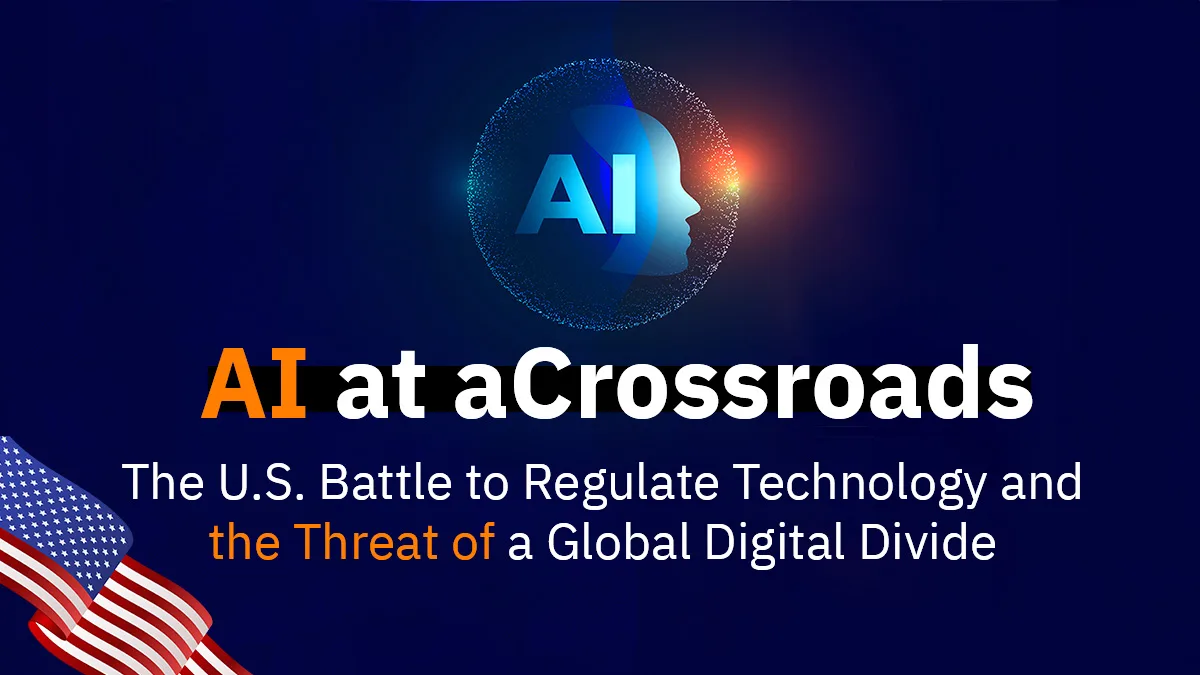AI at a Crossroads: The U.S. Battle to Regulate Technology and the Threat of a Global Digital Divide
By D. Kholoud Mahmoud

The United States is currently engaged in a decisive legislative and regulatory battle, with technology and artificial intelligence as its central focus. This is one of the most prominent issues dominating the current political and economic landscape. With the unprecedented pace of AI development, calls are escalating within the halls of Congress and the White House for urgent regulatory frameworks to keep pace with this technological boom.
This conflict is not limited to technical aspects alone but extends to issues of antitrust in the technology sector, where giants like Google and Meta face lawsuits and regulatory challenges aimed at curbing their market dominance. The rapid proliferation of AI also raises serious concerns about individual privacy, the impact of these technologies on the labor market, algorithmic bias, and national security. This frantic race between innovation and regulation will profoundly shape the digital future not only of the United States but of the entire world.
The Federal Vacuum and State-Level Initiative
Within the United States, the regulatory landscape is characterized by a tension between federal and state governments. A comprehensive legislative framework at the federal level that addresses the accelerating complexities of this technology is still absent. Despite the introduction of more than 100 bills in Congress, none have reached the stage of actual legislation, leading experts to predict only “minimal actions” at the federal level in 2025.
This legislative vacuum has prompted states like California to take the initiative and enact their own legislation in an attempt to fill the regulatory gap. However, these subnational efforts face a new challenge: the potential imposition of federal constraints under new national laws that could be issued soon. This reality creates a fragmented regulatory environment that poses complex compliance challenges for both startups and large companies, forcing them to navigate different and evolving legal systems in each state, thereby increasing compliance costs and sometimes hindering innovation.
Antitrust Through a National Security Lens
Antitrust issues in the field of AI are increasingly linked to matters of U.S. national security and foreign policy. The federal government, recognizing the strategic importance of AI technologies, has begun examining this nascent industry from a purely security-oriented perspective.
This approach is clearly evident in the strict restrictions imposed by the U.S. Department of Commerce on the export of advanced semiconductor technologies and high-performance computing chips, which primarily aim to limit China’s access to these critical technologies. These measures not only reflect security concerns but also indicate a fundamental shift in antitrust philosophy. Market competition is no longer the sole benchmark; technological dominance and the capabilities of geopolitical rivals have become a crucial factor in determining antitrust policies. This shift places American tech companies in a delicate position, caught between striving for global leadership and adhering to restrictions designed to maintain the nation’s technological superiority.
Public-Private Partnerships and Civil Liberties
Amid this complex regulatory scene, a growing trend toward deepening ties between leading AI companies and government agencies, including intelligence agencies, is emerging. Companies like Meta and Anthropic have established strategic partnerships with government institutions aimed at harnessing AI capabilities in areas such as big data analysis and cyber threat monitoring.
This convergence between sectors raises profound questions about the balance between national security and individual privacy, especially with the increasing use of technologies like facial recognition and predictive analytics in public spaces. It also sparks questions about the transparency of these partnerships and the extent of their democratic accountability. On one hand, these partnerships allow the government access to cutting-edge technology; on the other, they grant companies increased policy influence and potential exemptions from liability. This overlap of interests creates a new dynamic in the relationship between Silicon Valley and Washington, oscillating between strategic cooperation and mutual dependence, with far-reaching implications for civil liberties and democratic governance.
Socioeconomic Impacts and Global Repercussions
The policies regulating AI and technology antitrust in the United States have profound and dual effects on the economy and society. On one hand, they lead to tangible job losses, with 40% of employers globally expected to reduce their workforce in favor of automation, which exacerbates economic inequality.
Concerning business practices are also emerging, such as exploitative “dynamic pricing” in grocery applications that leverage personal data and consumer behavior to impose variable prices, violating individual privacy and threatening fair access to essential goods. Furthermore, pressure on companies to justify their massive investments in AI creates a new danger: the export of poorly designed and inefficiently tested models to less regulated developing markets. This transforms these technologies from tools of progress into factors that widen the global digital and economic gap.
The Core Dilemma: Innovation vs. Guardrails
Thus, the United States faces a genuine dilemma in its race to regulate AI: how to balance driving the wheel of innovation with establishing boundaries that protect society? The challenge lies not only in writing legislation but in writing intelligent legislation that anticipates the future. Excessive regulation may stifle creativity and cause America to lose its leading position, while lenient regulation may threaten privacy and worsen inequality.
In the end, success will not belong to those who draft the strictest laws, but to those who can build a flexible framework that combines the courage to innovate with the wisdom of regulation, because artificial intelligence is not just a technology—it is a force that will shape the destiny of humanity.